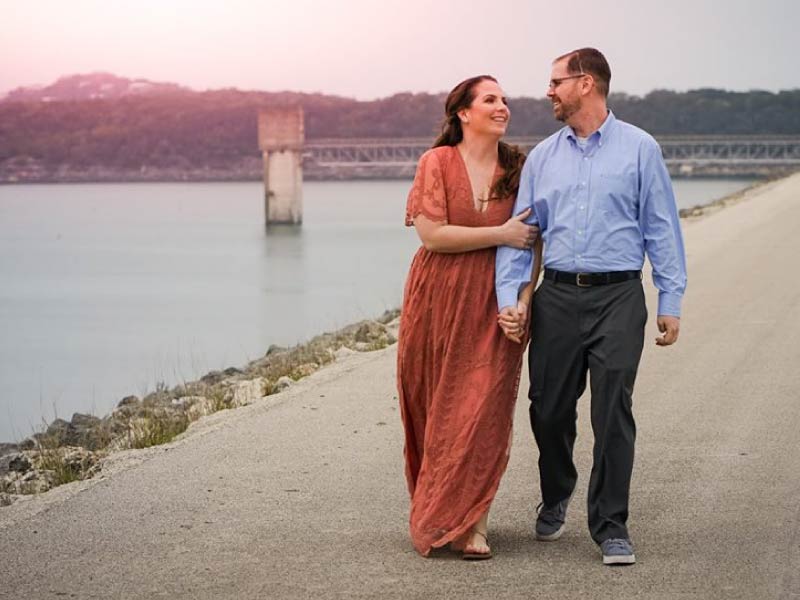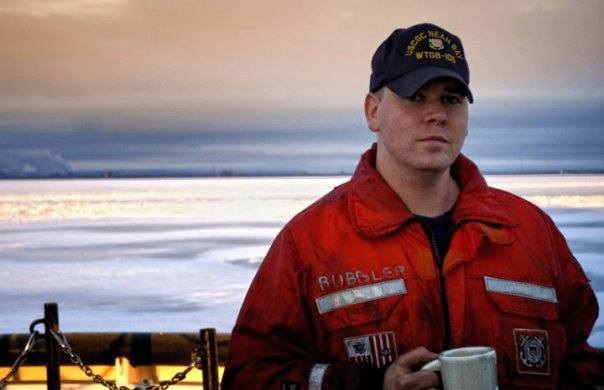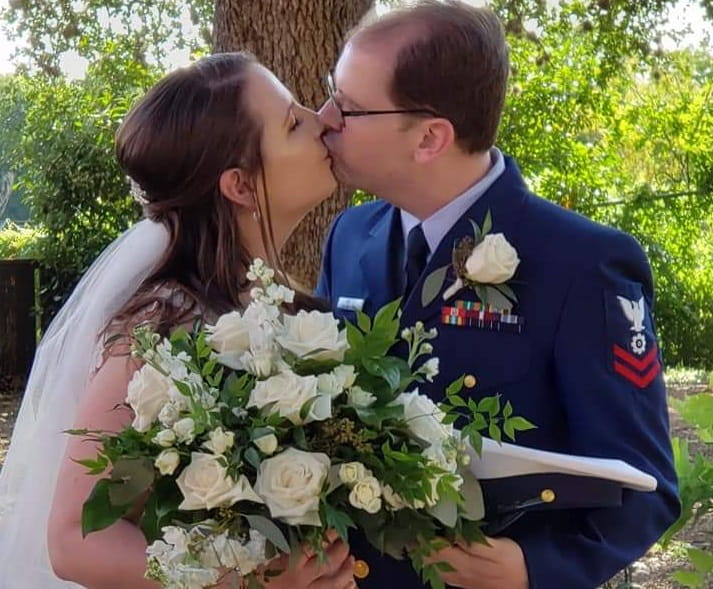She asked Google for a story about a Coast Guard stroke survivor. She found her soulmate.
By American Heart Association News

She grew up splashing around the Pacific Ocean. Him, the Atlantic Ocean.
She dreamed of a career in the Coast Guard. He had one.
About the only thing they had in common? Strokes that required extensive brain surgeries – her at 17, him at 23.
Since Saturday, they have something else in common. Their last name.
***
Tara MacInnes sat at her dining room table, flipped open her laptop and asked Google for help.
More than a decade after the diagnosis that ruined her chances of becoming a Coast Guard rescue swimmer, she learned that she couldn't even apply for a position she wanted at a VA hospital.
All her old feelings of regret and disappointment were percolating again. Now a mental health counselor, she gave herself advice: Find a distraction.
She wanted a sad story with a happy ending. She typed "Coast Guard" "cancer survivor."
Too many options. So she typed "Coast Guard" "brain surgery." Again, variety overload.
She tweaked her search to "Coast Guard" "stroke survivor."
This generated stories and videos about the same guy, Sean Bretz.
Tara spent the next half-hour reading and watching. She found him on Facebook, sent a friend request and went to sleep.
To fully appreciate what happened next, it's best to know everything that led to it.
***

Sean grew up in Wilmington Island, Georgia, on the outskirts of Savannah and essentially in the Atlantic Ocean. He was happiest while fishing, swimming or hanging out at the beach.
Two years out of high school, he struggled to find something that made him as happy. He cycled through six majors at three colleges and was still searching.
"Figure it out," said his mother, who'd always done exactly that while raising three kids by herself.
Finally, it clicked. The Coast Guard offered a career on the water.
A few years in, Sean was repairing engines and buoys – whatever needed fixing, really – as part of an Aids to Navigation Team in Jacksonville, Florida. He got a promotion in 2011 and went out to celebrate with friends.
He awoke the next day with more than a hangover. The worst headache of his life left him hardly able to move. The next day, he collapsed in the kitchen of a friend's apartment.
An aneurysm the size of a golf ball located near the base of his brain had just burst.
***
Surgeons implanted a stent so blood flow would bypass the damage. They also put Sean into a coma to reduce swelling.
A month later, he awoke.
His mind was sharp. He understood his predicament. Nobody knew this, though, because he could barely talk or move.
Sean, the fix-it guy, realized his mind was the only tool he could use. He sharpened it by thinking about people he'd seen be mentally tough when facing difficult circumstances.
He pictured his mom teaching herself to fix toilets and wiring in their house because she was determined to do it herself. He remembered the time a Coast Guard officer forged a drill bit from scratch in about 30 minutes rather than wait weeks for the manufactured part.
Sean coined a mantra: Adapt and overcome.
***
Doctors discovered Sean's paralysis came from cerebral spinal fluid not flowing properly. Through surgery and physical therapy, he began reusing his arms and legs.
A speech therapist showed him pictures of things like an apple and a cat. He seemed lost. Then she figured out why: He couldn't see.
When the aneurysm burst, blood pooled behind Sean's eyes. Now, more than five months later, surgeries cleaned it up. His clear view became a game-changer.
Within weeks, Sean went home. Eight months post-stroke, he went from a wheelchair to a walker. The next month, he told his mom, "No more," and began walking on his own.
Five months after that, he was driving. Two months later, he enrolled in school – to become a physical therapist assistant. Now fixed himself, he would help fix others.
Upon graduating, Sean was hired at a facility where he stayed briefly during his recovery. His therapist is now his boss.
"I absolutely love walking into a patient's room and sharing the story of me being in this person's exact position – with tubes coming out of everywhere – and showing them that I bounced back and recovered," he said.
Before work one morning, Sean saw Tara's friend request. He accepted.
***

When Tara was a child in California, nearly every Saturday she and her dad rode bikes to the beach. They swam, bodysurfed and played in the sand. Sometimes, they saw Navy Seals running with logs, dropping to the sand and doing situps as waves broke across their faces, logs still on their chests.
Those experiences melded into a declaration that she'd become a Coast Guard rescue swimmer. She was 5.
By 16, she seemed well on her way.
In middle school, she'd competed in the U.S. Open of synchronized swimming. In high school, Tara went from being a rare freshman to make the varsity swim team to also playing varsity water polo the next year.
Out of the water, there was another constant in Tara's life. Headaches.
***
Extremely colicky as a baby, Tara often came home from preschool saying she didn't feel well.
At 5, she was diagnosed with pediatric migraines. A doctor recommended tracking her activity, diet and even the weather when she had "episodes."
They occurred at least once a month, always following a pattern: She'd wake up with a migraine. Before noon, her speech slurred, vision blurred and/or she felt numb and tingly in her face, feet and hands. She usually vomited.
She was told to seek help only when an episode stretched beyond 24 hours.
"We lost count of the number of times we went to the ER," Tara said.
***
The Saturday before each school year, Tara's parents took her – their only child – out for dinner and a pep talk. To kick off her junior year, they went for barbecue.
While eating salad, Tara flung her fork and plopped her right arm onto the table. Numbness snaked from her shoulder through her torso, down her leg and into each toe. Her dad noticed her slumping sideways and caught her. She couldn't speak.
Ten minutes later, Tara was back to normal.
An MRI showed she'd suffered two sizeable strokes – one on each side of her brain. This didn't happen at the restaurant; doctors estimated they occurred when she was around 5, or younger. That meant every episode since was a transient ischemic attack, called a TIA or mini-stroke.
Doctors spent eight months seeking the cause.
"Before, I had some horrible days, but on good days, my health was not a major concern," Tara said. "Now my mind was preoccupied with being a stroke patient."
***
A brain scan showed what looked like a puff of smoke.
It was a cluster of collateral blood vessels the brain created to carry blood around the blockages from her strokes. It's the hallmark of moyamoya disease, a name that comes from the Japanese word for "puff of smoke."
The condition is found most commonly in Japan. In the United States, it happens to less than 1 in 100,000 people, usually between the ages of 5-15 and 30-40. Women are diagnosed more frequently than men.
Few places in the U.S. specialize in it. One of the best is Stanford University, which happened to be about 30 minutes from Tara's house.
In 2004, she underwent an eight-hour operation to bypass the stroke damage on the right side of her brain. A week later, another eight-hour operation did the same on the left side.
***
Once healed, Tara's world was upside down.
Her physical problems? Gone. But so was her hope of a career in the Coast Guard.
She began hunting for a new path. She lived at home for two years while attending San Jose State University.
A pleasant diversion became getting to know patients and families at the Stanford Moyamoya Center.
Tara and her mom became regulars in the surgery waiting room, sitting through roughly 40 operations with folks who'd usually traveled long distances and didn't have hands to hold or shoulders to cry on.
Tara and her mom steered people through the emotional minefield, something their family discovered the hard way. A rift that developed during Tara's first brain surgery resulted in relatives who'd been close no longer being part of their lives.
Families befriended by Tara and her mom thanked the neurosurgeon for having sent them. He hadn't. After hearing enough voluntary praise, Dr. Gary Steinberg hired Tara's mom.
Tara's dad was so inspired by her that after a long career helping lawyers create contracts, he went to law school. In his 50s. He's now a practicing attorney.
Tara, meanwhile, left home for her junior year of college still seeking direction. She was on her third college in her third state in three years, now studying nursing, when she realized it wasn't a good fit.
"Why not become a counselor?" her dad said. "That's what you've been doing all along with those moyamoya patients."
Another way of viewing the changes made by Tara and her parents in the wake of her brain surgeries: They adapted and overcame.
***
The morning Sean accepted Tara's friend request, she sent this message:
Following two weeks of exchanging Facebook messages, Sean wrote, "I want to hear your voice."
Soon they were talking every day.
Sean said he wanted to meet. He insisted on flying to visit her in San Antonio.
He stayed a week. The morning he flew home, Sean fulfilled a ritual for all first-time visitors to Tara's home. He wrote on her garage wall.
At the airport, saying goodbye was excruciating. Tara's tears dried as she raced home to see the message Sean left. She found this:
They spent Thanksgiving with Sean's family and Christmas with Tara's parents. In February, Sean flew to San Antonio for their birthdays, which are five days apart.
They agreed to meet again in June, this time in San Jose for the annual reunion at the Stanford Moyamoya Center.
On the flight, Sean thought about the fact Tara's family would be together and about her dad having the wedding ring she wanted: a three-diamond setting that belonged to her great-grandmother.
Somewhere high above the Western states, he decided, "Might as well."
During a cookout the night he arrived, Sean asked Tara's dad for permission to marry her and for the ring.
In the living room, in front of everyone, he popped the question.
Picking a wedding date was simple. It had to be the first Saturday in Stroke Month.
***

Before the ceremony, Tara and Sean exchanged vows privately. Not wanting to see each other yet, they spoke from opposite sides of a large oak tree.
Sean walked down the aisle in full Coast Guard uniform. It was the first time Tara saw him in it. She wore a champagne-colored dress with white lace.
The pastor finished by introducing them as Mr. and Mrs. MacInnes.
Not Bretz, his last name. He's taken hers.
Realizing her family name would end otherwise, the fix-it guy came up with this solution.
Their honeymoon involves moving Tara to Savannah. She hopes Georgia recognizes her Texas license as a mental health counselor. If not, she knows what to do: Adapt and overcome.
She also looks forward to sharing the exponential power of their stroke story, their individual tales multiplied by the quirky start to their courtship and, ultimately, their marriage.
"We just want to be there for others," she said.
Sean is eager do that, too. Eventually. For now, his priorities are "relaxing and enjoying each other's company."
Stories From the Heart chronicles the inspiring journeys of heart disease and stroke survivors, caregivers and advocates.
If you have questions or comments about this story, please email [email protected].







